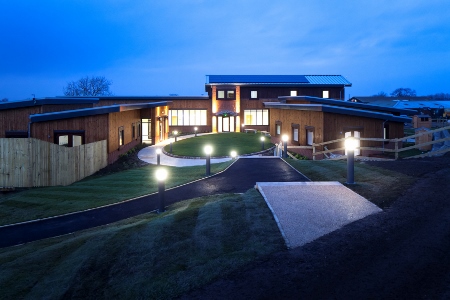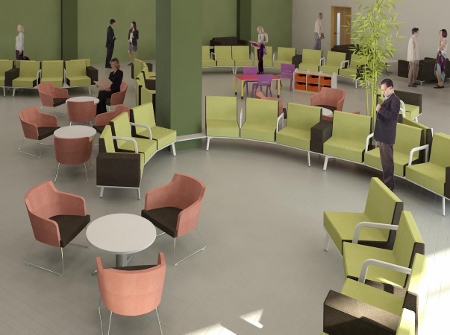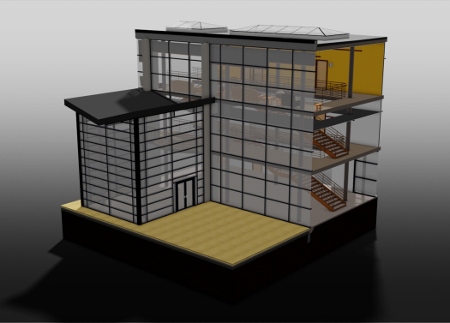One of the key buzzwords among architects and construction teams at the moment is BIM – or Building Information Modelling. This article explores what BIM really offers the market and how it could enhance healthcare projects in the future
BIM stands for Building Information Modelling, or Building Information Model, and describes the process of designing a building collaboratively using a system of computer-generated models, rather than separate sets of drawings.
It offers considerable cost and time savings and much greater accuracy, avoiding errors as multiple teams input into a design over the course of its creation. For example, to discover halfway through construction that wall panels or window specifications do not match the spaces described on the blueprints would mean major delays and lead to increased costs. To uncover this anomaly during the design process gives the team time to rectify the problem and ensure construction is not held up.
These gains are the reason why the Government revealed in its Construction Strategy 2011 that it would accelerate the adoption of BIM throughout the UK construction supply chain.
By 2016 – less than a year away - all centrally-procured Government projects will have to use fully-collaborative 3D BIM models. This will cover all project and asset information, documentation and data.
Getting it right
Dr Stephen Hamil, director of design and innovation and head of BIM at NBS, the national BIM library, explains: “BIM provides a digital representation of the building made up of objects that are related, starting with the building itself and moving down to the spaces that make up the building, then the systems and the products that make up the spaces, the relationship between these objects, and the constraints.
If a building is worth building, then it’s worth building twice, once digitally, then once physically
“The whole project team can work together to get key benefits. If a building is worth building, then it’s worth building twice, once digitally, then once physically. If you build it digitally first then you know it fits together properly. It’s about getting it right before you hand over to the construction team.”
A team led by the NBS won a £1m Innovate UK government contract to take forward development of a Digital Toolkit for BIM. This has the potential to transform the procurement of buildings and infrastructure by defining and testing the BIM data required at each stage of the project. It will also deliver the final two elements of the standards and guidance being provided by the UK Government prior to the 2016 BIM deadline.
The toolkit will make available a digital plan of work and a classification system that incorporates definitions for more than 5,000 construction objects at each of the delivery stages throughout the life of a built environment asset.
The project is seen as a vital part of the global race to develop an open standard and supporting tools for BIM adoption.
Capturing information
Hannah George, a BIM expert and senior associate of ICT and security at consulting engineers, Norman Disney & Young, said: “BIM allows you to really capture all the information in terms of design and, ultimately, 3D operation for a building - items that would otherwise be written in specifications and schedules in a big ring-binder folder kept under somebody’s desk. BIM brings all of that together and, by being in a central database, it also allows it to be well co-ordinated.”
David de Yarza, director of innovation at BNBuilders, and an early BIM adopter, added: “BIM is a lot of different things to a lot of different people, but to me it really represents a series or combination of processes that are technology enabled and are meant to increase understanding of a project.
“They are meant to help a design and construction team to communicate with each other, their clients, and the public what the project is all about. It is different things to different people, but in a nutshell it’s not just a piece of software, it’s about a process and a new way to do things.
“If I had to boil down the merit of what BIM really is for me; it comes down to risk management. By understanding a project really well, we take away the risk. As we all know, building projects nowadays are hugely complicated, so the more we can understand what everyone else in the design team needs, all the subcontractors, and the owners; the less risk we take on. By reducing risk, we increase profitability and improve customer service.”
To maximise the full benefits of BIM, the NBS advises that the building owner must own the model.
We are entering a new digital construction era that should position the UK as a global leader in BIM technology
As part of a BIM question-and-answer session organised by the NBS, Dr Hamil said: “If an engineer, for example, creates a BIM and does not share it, then the true benefits are not realised. The designs across the design team will not be fully co-ordinated; the construction team will not have the chance to model the construction process digitally, or will have to re-key the information to do this; and the building owner will be left to manage the facility with boxes of paper documents.
“To maximise the full benefits, the design team must share their information model, pass this to the construction team, and then place it in the hands of the building owner.
“A very simple analogy would be to compare BIM with commissioning a book or a photography session. If the client only received a physical book or prints at the end of the process that would be satisfactory, but receiving the digital content for the book or the original digital photographs is far more valuable. The client can reuse this content in future and get much better value out of it.”
Improving accuracy
All parties can benefit from BIM in the same way as when industry moved from drawing boards and typewriters to the first CAD and word processing systems in the 1980s. Everyone saved money, or made money, because processes became more efficient and accurate. If you made a mistake, you could undo it and, if you had to draw the same window 100 times, each copy was exactly the same as the first. Furthermore, if you wanted to find a particular word or phrase within a 100-page document, you could search for it in seconds.
Dr Hamil said: “Architects will no longer spend time retyping the data from a 2D CAD model into Microsoft Excel to produce a 200 instance door schedule; and they will not spend time going through a 150-page specification looking for each place they have requested the contractor to submit proposals or samples.
It’s a collaborative tool that is hopefully going to drag, not just new-build, but potentially retrofit projects, into the 21st Century
“The contractor will no longer be informed about clashes in the design by the structural and M&E engineers on site during construction, and they will be able to more-efficiently price projects by getting more-competitive prices when purchasing in bulk, with less waste. “Finally, the building owner will be able to manage and alter their facility using an accurate digital model of the physical building.”
BIM is already being widely used across the United States and in a number of Scandinavian countries, but its adoption in the UK has, until now, been piecemeal. An NBS survey in 2010 showed that nearly half of respondents were not aware of BIM. However, later in the survey, it emerged that 25% of those who were aware of BIM said they would adopt in on the majority of their projects within a year. 50% said they would adopt in on the majority of their projects within three years.
This increased interest is certainly evident within the healthcare market, where a growing number of suppliers have adopted BIM and created BIM-compliant product ranges.

Niven Architects used BIM when designing apartments for people with learning difficulties in Hemlington, near Middlesbrough
Early adopters
Help for those yet to make the move is provided in the Construction Products Association’s 2013 document: BIM for the terrified: A guide for manufacturers.
It states: “To be prepared for BIM, manufacturers and distributors will need to invest time and resources.”
It adds: “The Construction Products Association has worked with NBS to encourage sector trade associations to develop BIMs at a generic level for products, for example a brick, a WC, or an insulation board, so that designers have access to a range of products in BIM format. It is then up to individual companies to decide whether to take the next step and give the designer the opportunity to specify their particular products using BIM information.
“That decision revolves around an assessment of when making company-level BIM-compliant data available will become commercially essential. Certainly if the company’s products are used in central government contracts there will be a requirement to meet the Government’s BIM standards from 2016.”
Early adopters include aluminium façade specialist, Wicona, which has made components for its curtain walling, window and door systems, available to download from the BIMstore, an online portal for all BIM components.
“The implementation of BIM across the industry is set to change the dynamics and behaviours of the construction supply chain and should result in more-efficient and collaborative ways of working, which has to be very positive,” said Jon Palethorpe, director of Wicona.
“We are entering a new digital construction era that should position the UK as a global leader in BIM technology, and we are very pleased to be part of this important development.”
Architectural practices, Gelder and Kitchen and Niven Architects, are also supporters. Niven used BIM when designing a number of apartments for people with learning difficulties at the Larchfield Community site at Hemlington near Middlesbrough.
Mike English, general manager, said: “Using BIM enabled the members of the community to visualise their new homes with greater ease of understanding. Any adjustments were able to be made swiftly and cost effectively.
“The project is now to be referenced by the local social work department as a model for the transition of young people into adult services due to the successful way in which the planning and design of the building supported their very complex needs.
“The Niven team have been passionate about BIM from the start. It is about delivering a building that is very much fit for purpose and caters for very specific individual needs, while being attentive to future-proofing the building for the changing needs of those who will be living there.”
To be prepared for BIM, manufacturers and distributors will need to invest time and resources
Manufacturer, Roman, has invested in BIM for its key collections of shower enclosures, wetrooms, walk-in enclosures, bath screens, and shower trays.
Its managing director, David Osborne, said: “BIM is taking off at a speed and we knew without delay that we had to have our products available in the BIM format to ensure that we stay ahead in the industry.”
And Knightsbridge Furniture has made BIM components available to customers online. Alan Towns, managing director, said: “'As a furniture manufacturer supplying to the public sector, we feel it's vital to have our BIM files ready for architects and specifiers to access well in advance of the 2016 deadline.

Knightsbridge Furniture has made BIM components from its range available to customers online
“It was our goal to become one of the first UK contract furniture manufacturers to offer our clients the opportunity to easily download these files and we are delighted to embrace the future of BIM technology with the introduction of our open-source BIM files.”
Karl Redmond, chief executive of the Construction Sector Network, concluded: “If you ask the technical bods, as far as they are concerned, BIM is an amalgamation of various software packages pulled together to produce a 3D model that’s wonderful. From my perspective, and my personal background in banking, it’s a collaborative tool that is hopefully going to drag, not just new-build, but potentially retrofit projects, into the 21st Century. It is really going to drag them up by their boots straps and give them the necessary technology to take this built environment construction sector into more of a scientific world.”

Manufacturers, such as Roman and Wicona, are among the firms already offering BIM-compliant product ranges

